Surviving Koreatown:
Paradoxes of Shelter and Belonging
Survival, Community, and Isolation in the Face of Struggle
A Deep Dive into the Lives of the Homeless in Los Angeles
[Editor’s note: Late Pastor Lee Kang-won was once a man who dedicated his life to helping the homeless, only to tragically become one of them. In early July, he passed away alone on a street in Los Angeles’ Koreatown, a community he had once served. His death, however, is not an isolated tragedy—it reflects a larger, more harrowing reality. Countless others like him—people who were once pillars of the community—now live on its fringes, their lives hanging in the balance.
Over the past five months, we have spent time with these individuals, hearing their stories and sharing in their struggles. For them, Koreatown is a space of harsh contradictions. In this vibrant neighborhood, the homeless suffocate, fading into the background of a community that seems to have forgotten them. Amid the hustle and bustle, they fight to survive, their lives constantly threatened by the harshness of their circumstances.]
BY YEOL JANG, YOUNGNAM KIM
PHOTOGRAPHY AND VIDEOGRAPHY BY SANGJIN KIM
December 20, 2024
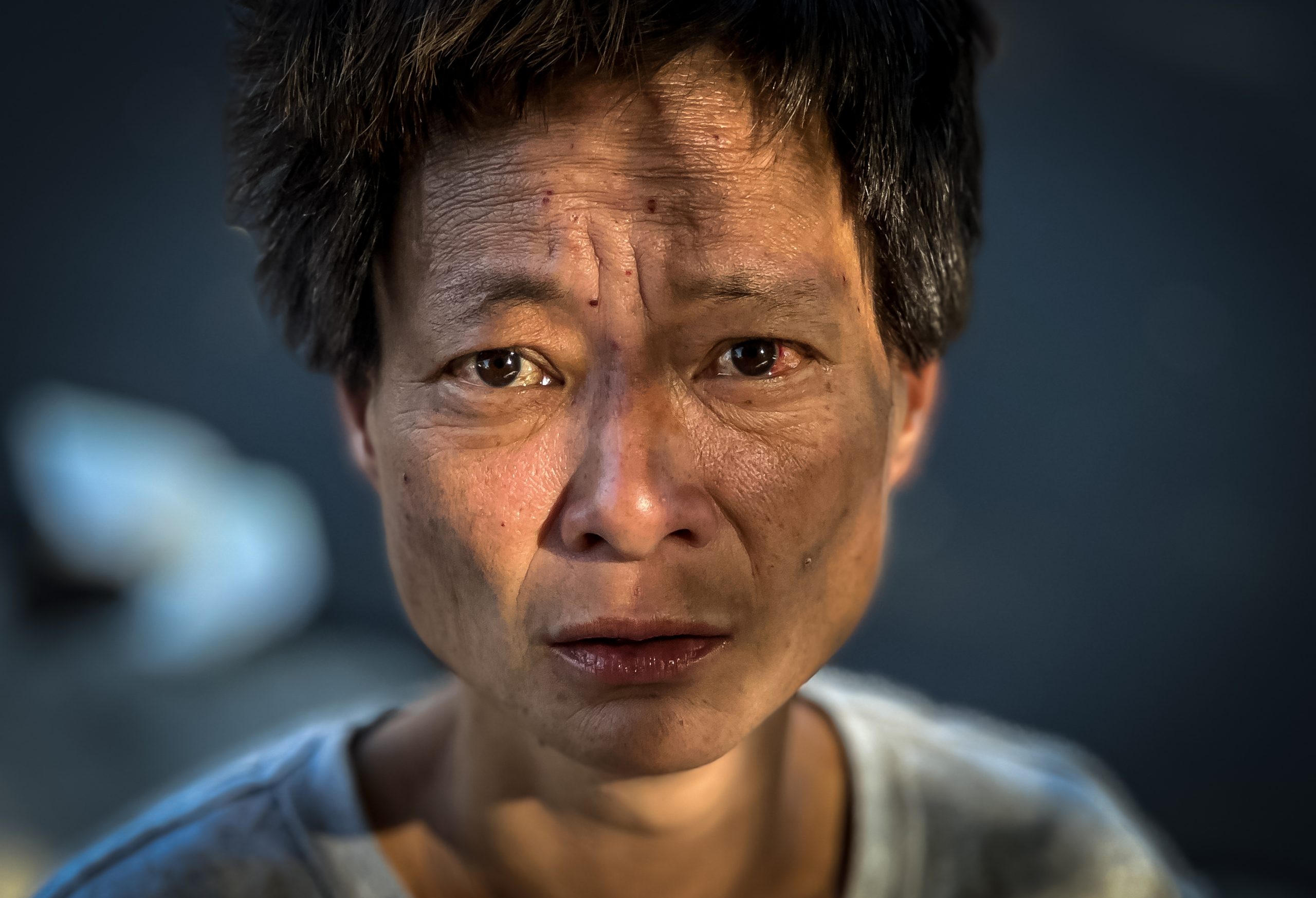
Episode #1
Cultural Bonds in Crisis
A Couple’s Struggle to Survive in Koreatown
The cold from the concrete floor made an elderly man shiver. A few tattered blankets offered minimal warmth in a small tent on Washington Boulevard in Los Angeles’ Koreatown.
Olivia, a 44-year-old Korean-American woman, sat beside the man, her collarbones barely visible beneath the thin fabric of her clothes. Her eyes filled with tears as she watched him.
“He is so sick,” Olivia said, her voice breaking. “He’s like the malnourished patients in North Korea.”

The man, lying on his side, gazed at them with tired eyes. Olivia’s voice trembled as she continued, “If you could bring him some porridge, maybe he could eat a little.” Her sobs grew louder. “If not, can’t you at least get him some soft tofu stew?”
For the elderly man with few teeth, soft tofu stew, or sundubu, is a comfort food cherished by Koreans in Los Angeles. For someone losing strength, it could be the sustenance they need to ease their pain.
[Related Article: From savior to Saved: The tragic tale of Pastor Lee]
The man, Yang Gye-hyung, 80, dearly loved this dish. Olivia introduced him as her husband.
“We’re married,” she said, though they were not legally married. They met at a Koreatown shelter, where others recognized them as a couple. Olivia, 44, and Yang share a bond forged by hardship.
“I don’t care what happens to me,” Yang said weakly.“I just want Olivia to find somewhere to stay.”
Olivia, trembling with emotion, interrupted, “My husband is dying. I desperately need somewhere to go.”
As they spoke, a neighbor complained, and the couple was forced to move their tent. Relocating was a painful reminder of their precarious existence.
Yang, with limited mobility, could barely stand, and Olivia, frail herself, struggled to move their belongings. It took them over 15 minutes to drag their tent just 300 feet.
Olivia has battled hallucinations for the past decade. She once lived in a Korean-American-only shelter run by Rev. John Kim at Saint James Episcopal Church, where she met Yang. But her mental health deteriorated, forcing her to leave.

Rev. Kim remembers Olivia well. “The shelter had an internal rule that only male homeless people could stay, but I made a difficult decision,” he said. “Her condition was serious, and I felt sorry for her, so I allowed her to stay.”
Over time, their relationship deepened. Yang took pity on Olivia, and they grew closer as they faced their struggles together. But as Olivia’s mental health declined, tensions arose. She began destroying things at the shelter, adding further challenges for both of them.
Rev. Kim recalls, “I knew her situation was serious, but I had to consider the impact on the other residents. It was difficult for everyone.”
Rev. Kim arranged for Olivia to be hospitalized multiple times through the mental health department. However, he noted, “The current healthcare system focuses more on medication and discharges once a patient’s condition improves, rather than providing fundamental treatment,” leading to a cycle of repeated readmissions and discharges.
Eventually, the shelter staff no longer wanted to take her in. Rev. Kim was forced to send Olivia back to the streets. Yang, despite the comfort of the shelter, chose to leave with her. His loyalty to Olivia kept him by her side.

At times, Olivia’s mental health fluctuated dramatically. She would speak in Korean, then suddenly switch to English, shouting, “I am perfect and beautiful,” before launching into a tirade against other residents. Meanwhile, Yang remained silent, staring blankly.
The couple, desperate for shelter, expressed their fear about leaving Koreatown. When asked if they could stay at a motel or a city-arranged shelter, Olivia responded with visible anxiety.
“We’re too afraid to leave Koreatown,” she said. “I don’t trust anyone but Koreans.” She explained that a Korean homeless man had shared a traumatic experience in a non-Korean shelter, where he was assaulted and kicked out. “My husband only speaks Korean,” she added, “and he’s afraid of others. I’m afraid too.”
For Olivia and Yang, the streets of Koreatown are not just a place of residence but a sanctuary, where trust is rooted in shared language and culture. In a city with numerous resources, their story is a stark reminder of how isolation and fear can trap even the most vulnerable in a cycle of homelessness and despair.
Episode #2
Caught Between Dream and Reality
North Korean Defector’s longing for paradise

In the heart of Los Angeles’ Koreatown, Choi Jung-chul, a 59-year-old North Korean defector, sits quietly in a homeless shelter. With a cigarette between his fingers and a smartphone in hand, he scrolls through property listings—a daily ritual that speaks to a dream far larger than his current circumstances.
“Why is land in LA so expensive? I can’t imagine,” Choi mutters, exhaling a long stream of smoke. His eyes, weathered by decades of hardship, remain fixed on the screen, scanning listings that represent something more than mere real estate: a vision of sanctuary.
Choi’s dream is both simple and extraordinary. He wants to purchase land and build a large house—not for himself, but as a refuge for struggling North Korean defectors. “There are many North Koreans in the U.S.,” he said. “One day, I’m going to buy land and build a big house for all of them. I want to help.”
This aspiration is rooted in a lifetime of challenging experiences. Born in North Korea, Choi grew up under a regime that promised its citizens a “paradise on earth”—a promise quickly shattered by the realities of hunger, poverty, and oppression.

His journey began in 1995 when the North Korean government sent him to Khabarovsk, a harsh city in Russia’s Far East. As a logger, Choi spent five grueling years cutting timber under brutal conditions. The freezing Siberian winters and relentless work drove him to a breaking point. He faced a dire situation when he had to return to North Korea. “I had nothing to lose,” he recalls. “So, I jumped off the train and ran.” Without revealing too many details, he said, “I helped someone, but it caused a misunderstanding.”
The years that followed were a testament to the indomitable human spirit. Without legal status in Russia, Choi worked in potato fields and took on plastering jobs, constantly moving across Russia. He endured beatings, wage theft, and unimaginable hardships.

These experiences left permanent marks—he is now partially deaf in his right ear, a consequence of the numerous assaults he suffered.
A turning point came when a Korean-American pastor secretly helped him begin the asylum process through the U.S. embassy. After being vetted by the United Nations High Commissioner for Refugees, Choi arrived in the United States in 2011.
His American journey was not the instant transformation he had hoped for. He worked as a day laborer, moving between states like Kentucky, Ohio, and North Carolina. Despite the language barrier, his life was markedly better than his days in North Korea and Russia. However, 13 years of physical labor eventually took their toll, leaving him unable to work and forcing him back to the streets.
A fellow defector suggested Los Angeles, with its warmer climate and larger Korean-American community. He found refuge in a shelter run by Rev. John Kim at Saint James Episcopal Church in Koreatown.
For Choi, this shelter represents an unexpected version of his long-sought paradise. “Here, I have a comfortable place to sleep, Korean food, and I can easily communicate in Korean. I have the freedom to do as I please,” he says.

Undeterred by his physical limitations, Choi has begun investing in stocks and cryptocurrency—his method of navigating a capitalist system that once seemed incomprehensible. Yet, the amounts are minimal, his dream of land ownership still distant.
“I always dream of that paradise, but I don’t have the courage to leave,” he admits. “I don’t speak a word of English and I’m not in good health. Where can I go? It’s too scary to think about leaving here.”
Even as he remains rooted in the shelter, Choi takes another deep drag of his cigarette. His eyes begin to well up as he speaks. “I really want to help the North Koreans who are sleeping on the streets,” he says, his voice heavy with emotion. “That’s the last paradise on earth I dream of.”
Perhaps Choi is caught in an unresolved conflict between the comfortable life in the shelter and the vague paradise he seeks. The reality of homelessness remains an undeniable constraint—a cage that, while providing temporary refuge, also limits his ability to fully realize his dreams.

Episode #3
A Miserable Treasure Island
A Homeless Man’s Dilemma of Survival

In the heart of Los Angeles’ bustling Koreatown, a seemingly peaceful neighborhood conceals a stark and often overlooked reality. Behind a white wooden house, a cache of stolen goods tells a complex story of survival.
Jeon Myung-oh, a 65-year-old homeless man, guides us into this hidden world, his floral shirt and baseball cap creating a jarring contrast with the grim narrative he’s about to share. Holding up a pair of sunglasses, he asks with a mix of pride and defiance, “How much do you think these are worth? Around $400 to $500. Isn’t that pretty cool? These are all stolen, and I bought them.”
His collection is eclectic and telling: bicycles, electric scooters, golf clubs, and luxury suitcases pile high. Interspersed among these valuable items are more poignant markers of his life—old crockery, empty liquor bottles, and a worn-out couch that speak to a life lived at the margins.
This “treasure trove” isn’t tucked away in a private home. Instead, it resides in a shelter owned by a Korean-American family, providing shelter to more than 20 homeless people, most of them Korean-Americans like Jeon. The items, he explains, are brought here because the people who steal them have no alternative marketplace. “We find buyers for it,” he says, describing an underground economy of survival.

Jeon arrived in the U.S. in 1975, and his fluent English suggests an initial ease of adaptation. Yet his experience in Koreatown reveals a far more complicated reality of immigrant life.
“Everybody here is six feet under,” Jeon says, using the burial metaphor to describe a profound sense of hopelessness that permeates the shelter. “We’re all at the lowest point in our lives,” he adds, his voice laden with bitterness.
During our interview, the tension becomes palpable when another man suddenly appears, shouting in Korean, “What are you doing, why are you taking pictures?”
Jeon quickly intervenes, calming the situation with a few words. His apparent authority in the shelter is an ironic testament to a world where survival skills matter most.
Lifting his left arm, Jeon reveals a scar. “The gangs in Koreatown did this to me,” he says. “I was stabbed many times while living on the streets.” His words paint Koreatown as more of a battleground than a community for the homeless.
For Jeon, the neighborhood is simultaneously a sanctuary and a war zone—a place where he can collect valuable items and find temporary refuge, but also where his life and safety are constantly at risk. “The police don’t help us,” he says, shaking his head. “If there’s a gang fight or something happens, they don’t intervene. They just walk away because we’re homeless. It’s a harsh reality that just dehumanizes us even more.”

He draws a sharp contrast with more affluent neighborhoods. “Beverly Hills has money, so when you call, the police show up. But here, in Koreatown, it’s different.”
As Jeon continues to show items in his yard, his criticism of the support system for homeless people becomes more pointed. Despite the harsh conditions, he explains why he cannot simply leave Koreatown.
“Even if someone is behaving erratically with a potentially dangerous tool on the street, Koreans often hesitate to report it, viewing them as part of the community,” he says. “They feel a sense of compassion for their own people. That’s why we stay, and that’s why I can’t leave either.” His voice is weary but resolute.
Before homelessness, Jeon worked as a handyman. His life took a downward spiral six years ago when he turned to drugs. Now, he lives among the homeless, having gained an intimate understanding of the community’s complexities. He is particularly critical of social workers.
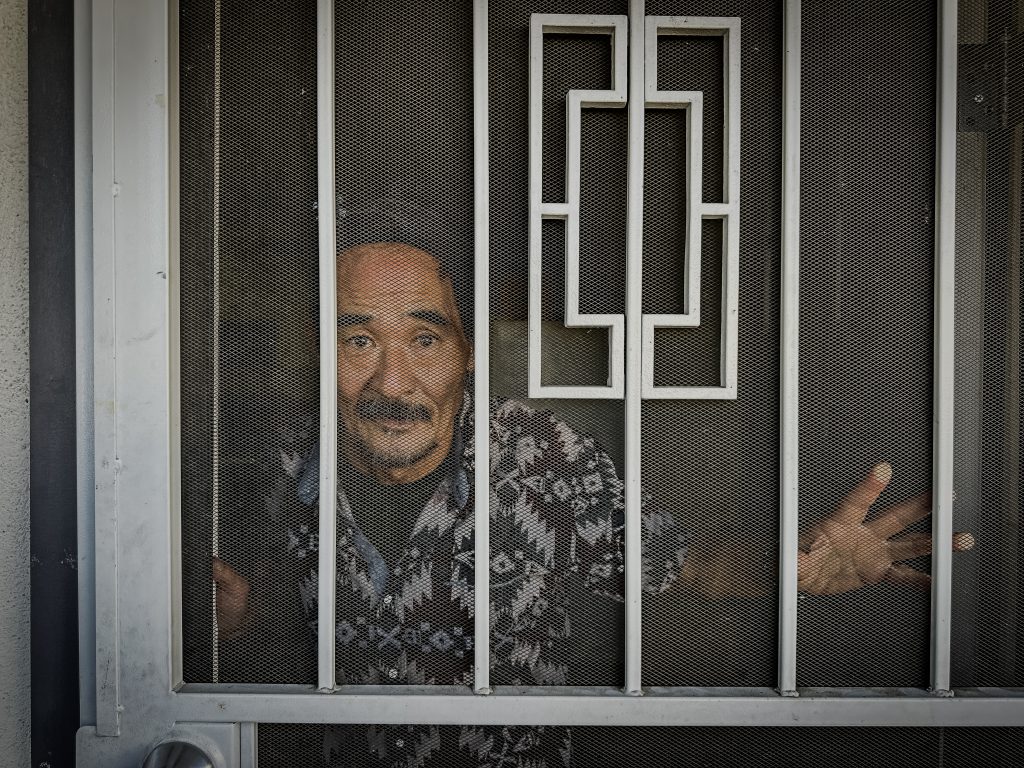
“When the social workers come here, they only see the organized living room,” Jeon says, referring to the clean, controlled parts of the shelter. “They don’t really understand how we live. They make decisions that are out of touch with reality.”
He argues that while social workers have good intentions, they fail to comprehend the unique challenges of homeless life in Koreatown—a community often ignored or misunderstood.
For Jeon, Koreatown represents a paradox—both a paradise and a prison. It provides access to valuable items while simultaneously trapping him in a cycle of hardship, danger, and mere survival. His situation epitomizes the irony of a man surrounded by “treasures” yet unable to escape profound poverty and despair.
Koreatown has become his miserable treasure island—a place where Jeon finds both his greatest riches and his deepest struggles, an endless loop that confines him to a harsh reality with no apparent escape.
Episode #4
The Price of Belonging
Trapped Between Familiarity and Rejection

In the heart of Los Angeles’ Koreatown, a small, cluttered alley next to a bustling mall of Korean-owned businesses tells a quiet, tragic story. The alley, tucked away from the vibrant streets lined with bakeries, restaurants, and hair salons, is home to Yoon Ae-bok, a 65-year-old Korean-American homeless woman who has lived there for a decade.
Unlike the neon lights that adorn Koreatown’s storefronts, this alley is dark and rarely seen by the public. It lacks even a name, and its air is thick with the stench of waste—discarded plastic bottles, old furniture, and human feces litter the ground. Yet for Yoon, this forsaken stretch of land offers something more important than the cleanliness or order of the outside world: a place where she feels a sense of belonging.
Yoon’s story reflects the harsh realities many homeless individuals in Koreatown face—often invisible, yet deeply tied to the community. Despite the unsanitary conditions, Yoon has made the alley her home.
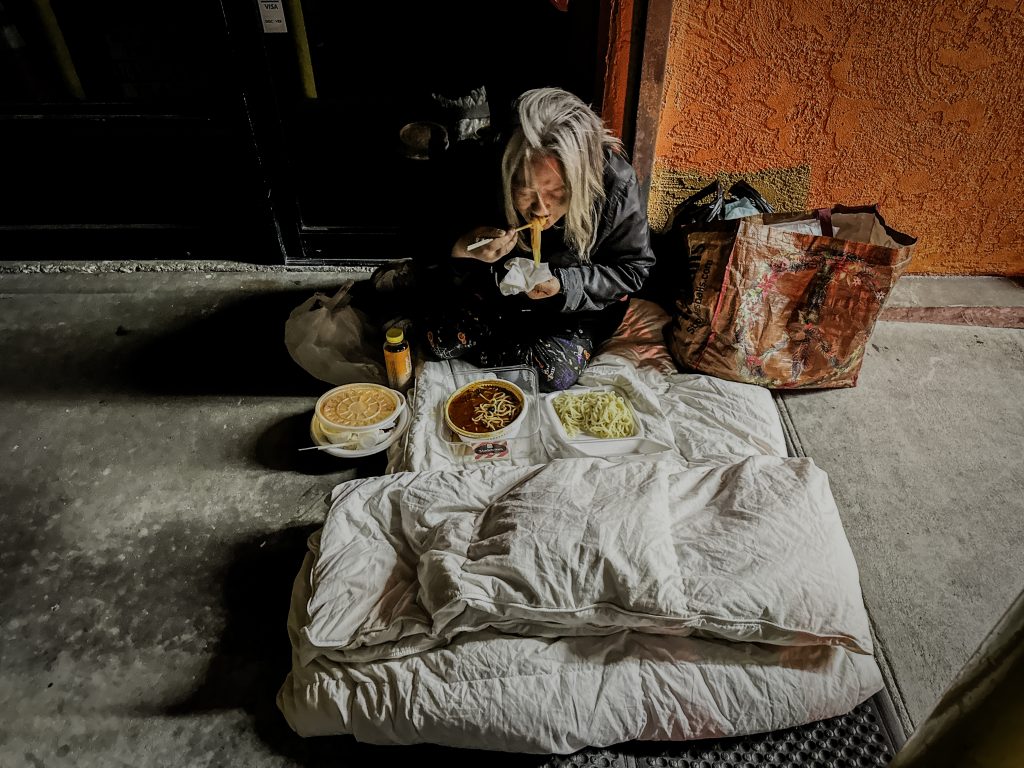
City officials working under Los Angeles’ Inside Safe program, launched by Mayor Karen Bass to provide temporary housing for the homeless, approached Yoon with an offer. The program aims to help people move from the streets into shelters or motels—temporary homes meant to offer a semblance of stability.
“Would you like to move to temporary housing through this program?” an official asked Yoon, extending an opportunity for a new life beyond the alley.
Yoon paused, her voice slow and tinged with experience. “I want to go in, but I’ve already been in and out six times,” she replied, frustration and resignation evident in her words.
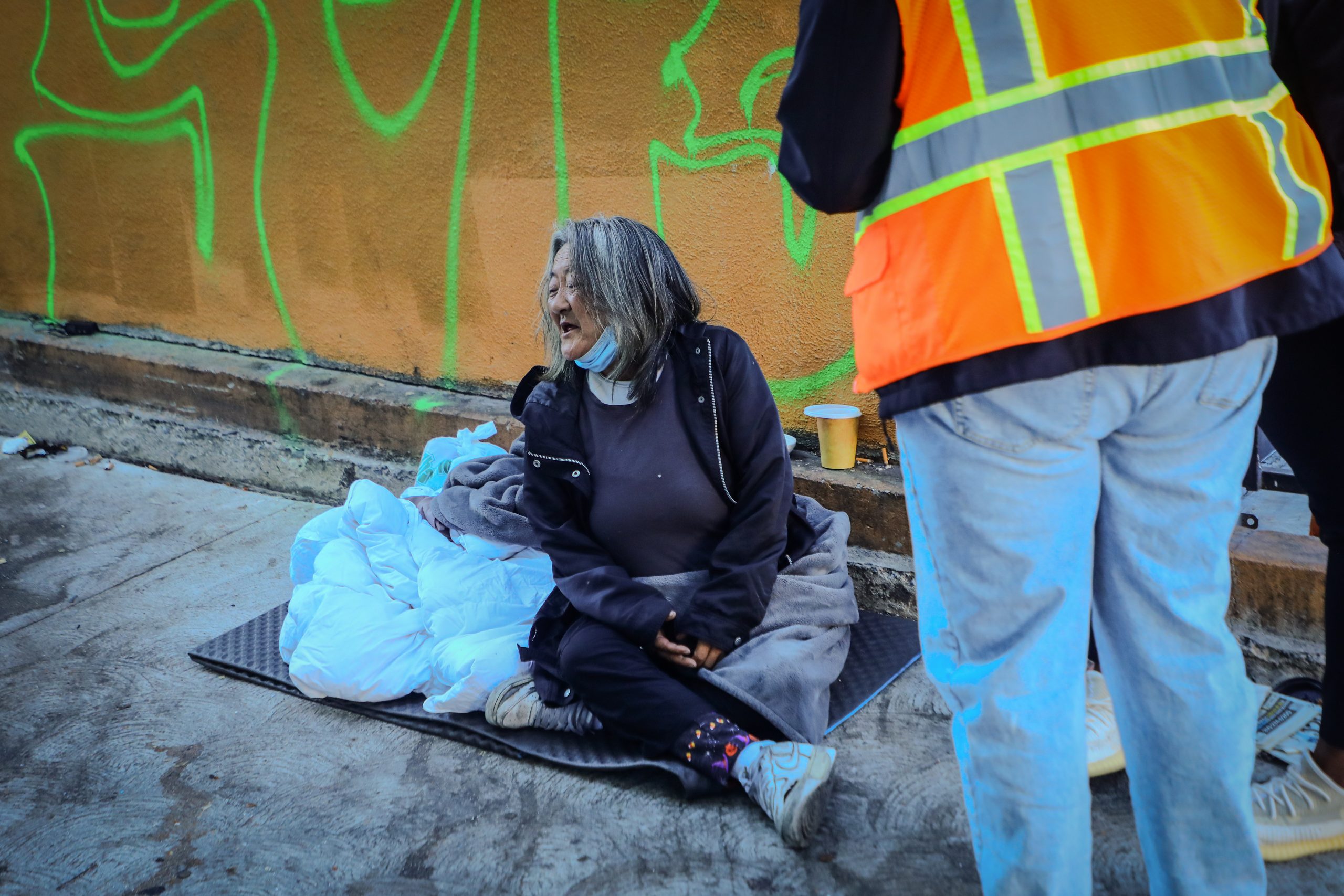
Although she spoke in English, her words were unclear, prompting the official to ask if she needed a Korean interpreter. A quick call connected them to someone who could translate, and after a brief exchange, Yoon agreed, in Korean, to accept the shelter offer.
“Yes,” she said softly, and the officials began packing her belongings into two large plastic bags in preparation for the move to a motel. But as they prepared to leave, a new hurdle emerged.
“Where is the motel?” Yoon asked, her voice tinged with suspicion.
“It’s about six miles from here,” the official replied.
Yoon’s demeanor changed instantly. “I’m not going there,” she said firmly, her voice rising with frustration.
The officials, perplexed, tried to convince Yoon to reconsider, but the more they urged, the more resolute she became.
“I don’t want to go, not today,” she repeated, dismissing their efforts.
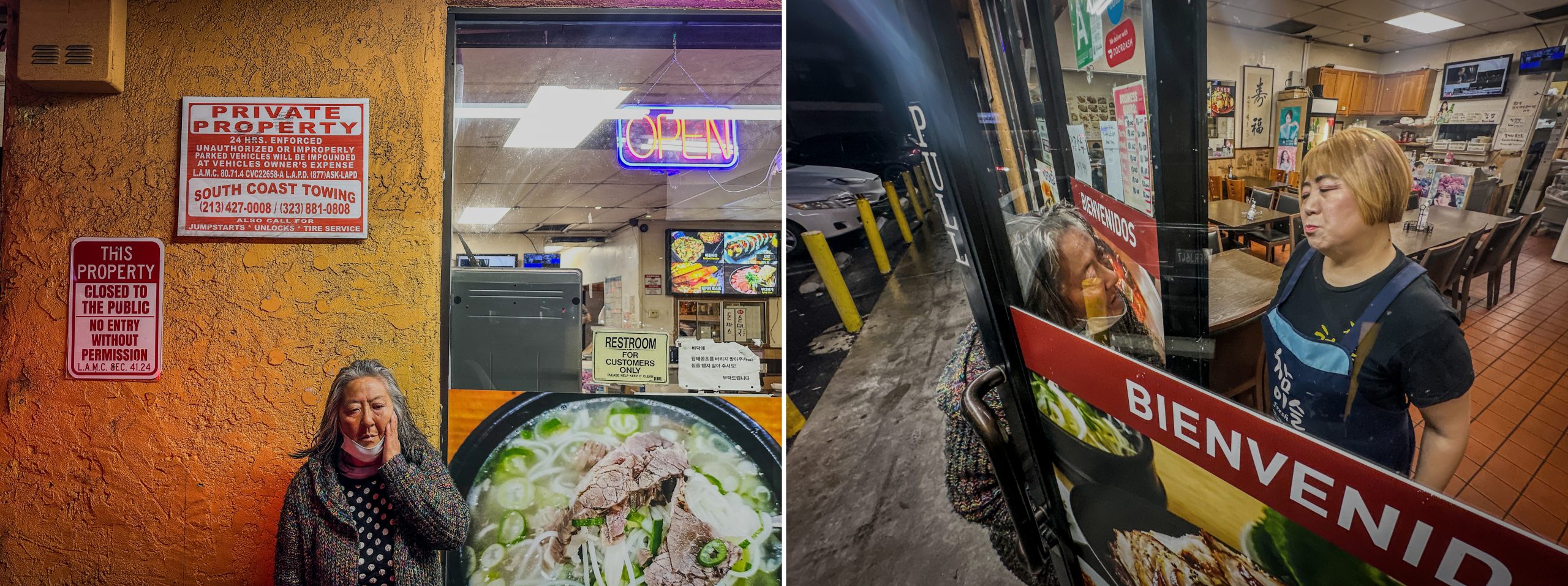
Eventually, the officials were forced to back off. According to regulations, they cannot force someone into shelter if they refuse, no matter the circumstances. Yoon’s belongings were left in their bags on the street, and the officials, including medical staff from the Inside Safe program, retreated.
We cautiously asked Yoon, “Why aren’t you going to the motel? Is it because six miles seems too far?”
Yoon nodded, confirming that distance was part of the issue. “I like it here,” she said simply. “I don’t like it anywhere else.”
Once again, Yoon was left alone in the alley that has become her home, surrounded by the refuse others reject. Yet, even in this space, there is a sense of community—though not everyone shares the same warmth.
Business owners in the mall near the alley are frustrated by her presence. “I wish she would go somewhere else,” said the owner of a nearby hair salon, speaking bitterly. “She defecates everywhere, it stinks, and it makes our customers uncomfortable.”

The owner’s frustrations grew, and in a burst of anger, he marched outside, shouting at Yoon. “Please leave here. Even if you die, don’t die here, go die somewhere else.”
Yoon remained unfazed, her head bowed in silence as the harsh words flew. Her only response was the cold noodle soup someone had delivered to her, sitting untouched before her.
The antagonism toward Yoon is not an isolated sentiment. Other business owners in the area share similar frustrations. “Sometimes I don’t see her, but she always comes back here,” said Park Eun-kyung, who runs a nearby Korean style Chinese restaurant.
“Homeless people tend to think of a place as home once they settle in, so even if they leave, they always come back.”
In this alley, where Yoon finds a semblance of peace, she is unwelcome. Yet moments of compassion shine through the coldness.
“I honestly don’t like her, but I’ve given her food a few times,” Park said. “And I’ve seen many customers bring her food after they’ve eaten.”
Nearby, at the office of New Star Realty, a prominent Korean-American real estate company, Alex Nam, a director, often sees Yoon as he passes by the alley. “I know her well,” he said. “I pass by there every time I go to lunch, and if I see her, I sometimes give her a little money.”
Yoon’s struggles with hunger are well-known in the community. One rainy evening, a middle-aged Korean-American man stopped by the alley and asked, “Have you had dinner?”
“I haven’t eaten all day,” Yoon replied groggily.

The man offered to take her to a nearby restaurant, where he ordered her tteokguk (Korean rice cake soup), a Korean dish. As they arrived, a waitress greeted them with an offended expression, asking what was going on. After a quick exchange, the man handed her $20 to cover the meal, and Yoon was told to wait outside. Ten minutes later, the waitress returned with the food and a brief, “Enjoy it.”
Yoon, once again, retreated to her spot in the alley, where she laid out Korean newspapers on the ground to use as utensils. As she ate, she gazed at the date printed on the paper, her face blank.
“Is this the day of the week?” she asked, perhaps unsure of the time that had passed.
In that moment, it seemed the Korean characters on the newspaper were a reminder of her place in this community—one that, despite its challenges and occasional cruelty, still claims her as part of its own. Even if she is isolated in a trash-strewn alley, Yoon cannot escape Koreatown. And for all its flaws, this neighborhood still carries her name.
